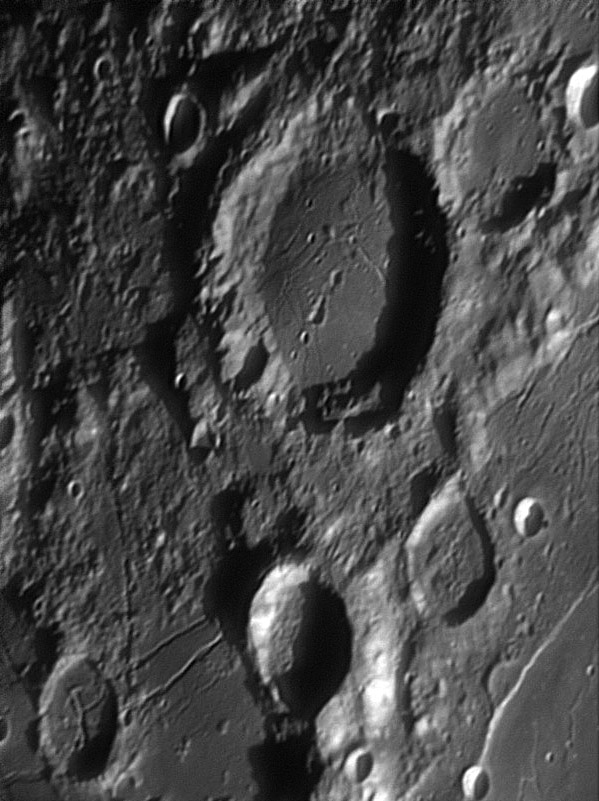|
|
| (7 intermediate revisions by the same user not shown) |
| Line 1: |
Line 1: |
| | __NOTOC__ | | __NOTOC__ |
| | =A Beer Belly Crater= | | =A Beer Belly Crater= |
| | + | <!-- Start of content --> |
| | <div class="post" id="post-1554"> | | <div class="post" id="post-1554"> |
| | | | |
| Line 6: |
Line 7: |
| | <p>[[File:Mersenius-Grenier-video0069-07-11-21-21-04-07.jpg|Mersenius-Grenier-video0069-07-11-21-21-04-07.jpg]]<br /> | | <p>[[File:Mersenius-Grenier-video0069-07-11-21-21-04-07.jpg|Mersenius-Grenier-video0069-07-11-21-21-04-07.jpg]]<br /> |
| | <em>image by [mailto:jeromegrenier@free.fr Jérôme Grenier], Paris, France.</em></p> | | <em>image by [mailto:jeromegrenier@free.fr Jérôme Grenier], Paris, France.</em></p> |
| − | <p>Floor-fractured craters are the most interesting ones on the Moon because of their concentration of rilles, dark halo craters and uplifted centers. While some have easily visible rilles ([http://www.lpod.org/?m=20071129 Posidonius] and [http://www.lpod.org/?m=20060309 Gassendi], for example) others have such narrow rilles that they are rarely imaged. [http://www.lpod.org/archive/LPOD-2004-10-06.htm Cleomedes] is an example of the latter, and so is Mersenius, shown above. Mersenius has long been known for its convex floor, although I am unaware of any measures of its height other than Neison’s statement in his 1876 book, <em>The Moon</em>, that <em> the centre is perhaps 1500 ft higher than the foot of the walls.</em> Schmidt detected two rilles on the floor, but they have been difficult for observers to consistently depict. Jérôme’s image - only the second [http://www.lpod.org/archive/archive/2004/04/LPOD-2004-04-03.htm one] to clearly show them - reveals most of the rilles known from Lunar Orbiter IV photography. The rilles crudely circle the floor, especially on the south, west and north, and a very faint one cuts across the nearly featureless southeast quadrant of the floor. Although it is not visible here, on the high Sun Clementine [http://the-moon.wikispaces.com/Mersenius image] four dark pyroclastic deposits are visible along the western edge of the floor. At least one dark spot is from a dark halo crater on a rille. A question that I don’t have a definite answer for is why do Mersenius and Cleomedes have such narrow rilles while most floor-fractured craters have broader ones? Presumably the amount of floor fracturing - and thus rille width - is related to the amount of bending from uplift of the floor. Do these two craters have less uplift than Gassendi, Posidonius and Alphonsus?</p> | + | <p>Floor-fractured craters are the most interesting ones on the Moon because of their concentration of rilles, dark halo craters and uplifted centers. While some have easily visible rilles ([[November_29,_2007|Posidonius]] and [[March_9,_2006|image]] four dark pyroclastic deposits are visible along the western edge of the floor. At least one dark spot is from a dark halo crater on a rille. A question that I don’t have a definite answer for is why do Mersenius and Cleomedes have such narrow rilles while most floor-fractured craters have broader ones? Presumably the amount of floor fracturing - and thus rille width - is related to the amount of bending from uplift of the floor. Do these two craters have less uplift than Gassendi, Posidonius and Alphonsus?</p> |
| | <p>[mailto:tychocrater@yahoo.com Chuck Wood]</p> | | <p>[mailto:tychocrater@yahoo.com Chuck Wood]</p> |
| | <p><strong>Technical Details:</strong><br /> | | <p><strong>Technical Details:</strong><br /> |
| Line 13: |
Line 14: |
| | Rükl chart 51<br /> | | Rükl chart 51<br /> |
| | [http://www.lpi.usra.edu/resources/lunar_orbiter/bin/info.shtml?418 Lunar Orbiter IV view]</p> | | [http://www.lpi.usra.edu/resources/lunar_orbiter/bin/info.shtml?418 Lunar Orbiter IV view]</p> |
| − | <p align="center"> | + | <p><b>Yesterday's LPOD:</b> [[November 29, 2007|Not from Orbit]] </p> |
| − | <i>Christmas shopping has now officially started. You support [http://www.lpod.org/?page_id=591 LPOD] when buying lunar books (or ANY Christmas present) from Amazon!</i></p> | + | <p><b>Tomorrow's LPOD:</b> [[December 1, 2007|Another Lunar Atlas?]] </p> |
| | + | <!-- Removed reference to store page 2 --> |
| | </div> | | </div> |
| − | ---- | + | <!-- End of content --> |
| − | ===COMMENTS?===
| + | {{wiki/ArticleFooter}} |
| − | Click on this icon [[image:PostIcon.jpg]] at the upper right to post a comment.
| |




